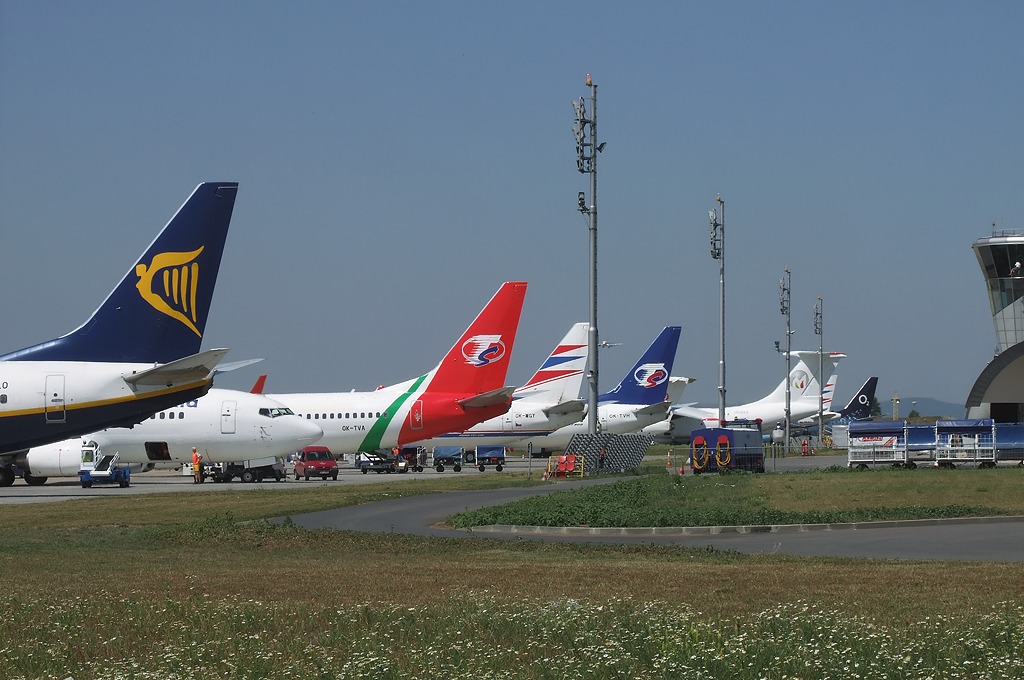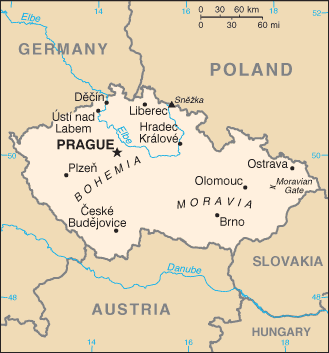|
Moravia (other)
Moravia ( cs, Morava ; german: Mähren) is a historical region in the east of the Czech Republic and one of three historical Czech lands, with Bohemia and Czech Silesia. The medieval and early modern Margraviate of Moravia was a crown land of the Lands of the Bohemian Crown from 1348 to 1918, an imperial state of the Holy Roman Empire from 1004 to 1806, a crown land of the Austrian Empire from 1804 to 1867, and a part of Austria-Hungary from 1867 to 1918. Moravia was one of the five lands of Czechoslovakia founded in 1918. In 1928 it was merged with Czech Silesia, and then dissolved in 1948 during the abolition of the land system following the communist coup d'état. Its area of 22,623.41 km2 is home to about 3.2 million of the Czech Republic's 10.9 million inhabitants. The people are historically named Moravians, a subgroup of Czechs, the other group being called Bohemians. The land takes its name from the Morava river, which runs from its north to south, being its pr ... [...More Info...] [...Related Items...] OR: [Wikipedia] [Google] [Baidu] |
Mikulov
Mikulov (; german: Nikolsburg; yi, ניקאלשבורג, ''Nikolshburg'') is a town in Břeclav District in the South Moravian Region of the Czech Republic. It has about 7,400 inhabitants. The historic centre of Mikulov is well preserved and is protected by law as an urban monument reservation. Administrative parts Mikulov is made up of one administrative part. Geography Mikulov is located about northwest of Břeclav, on the border with Austria. It borders the Austrian municipality of Drasenhofen. Mikulov lies mostly in the Mikulov Highlands, but the municipal territory also extends into the Lower Morava Valley on the east and into the Dyje–Svratka Valley on the west. The highest point is the hill Turold with an elevation of . Most of the territory lies within the Pálava Protected Landscape Area. The Mušlovský and Včelínek streams flow through the territory and supply a set of ponds, the largest of them are Nový with an area of and Šibeník with . Other not ... [...More Info...] [...Related Items...] OR: [Wikipedia] [Google] [Baidu] |
Ostrava
Ostrava (; pl, Ostrawa; german: Ostrau ) is a city in the north-east of the Czech Republic, and the capital of the Moravian-Silesian Region. It has about 280,000 inhabitants. It lies from the border with Poland, at the confluences of four rivers: Oder, Opava, Ostravice and Lučina. Ostrava is the third largest city in the Czech Republic in terms of both population and area, the second largest city in the region of Moravia, and the largest city in the historical land of Czech Silesia. It straddles the border of the two historic provinces of Moravia and Silesia. The wider conurbation – which also includes the towns of Bohumín, Havířov, Karviná, Orlová, Petřvald and Rychvald – is home to about 500,000 people, making it the largest urban area in the Czech Republic apart from the capital Prague. Ostrava grew in importance due to its position at the heart of a major coalfield, becoming an important industrial engine of the Austrian empire. During the 20th centur ... [...More Info...] [...Related Items...] OR: [Wikipedia] [Google] [Baidu] |
CZ Traffic Sign IS16a - D35
CZ, C-Z, C/Z, or Cz may refer to: * Czech Republic, ISO 3166 country code CZ * .cz, internet country code top-level domain for the Czech Republic Businesses and organisations * C/Z Records, an American record label * Česká zbrojovka firearms (ČZ) ** Česká zbrojovka Uherský Brod, a Czech firearms manufacturer *** CZ-USA, U.S. division ** Česká zbrojovka Strakonice (ČZ a.s.), a Czech manufacturer of forklifts and formerly motorcycles and firearms * Cizeta, an Italian car manufacturer named for its founder, Claudio Zampolli (C.Z.) * China Southern Airlines, IATA airline designator CZ Science and technology * Cubic zirconia, a synthetic gemstone * Haplogroup CZ (mtDNA), in human mitochondrial genetics * Controlled Z gate, a type of Quantum logic gate * Long March (rocket family), or Chang Zheng * Cz, an EEG electrode site according to the 10-20 system * Changpeng Zhao, founder and CEO of cryptocurrency exchange Binance Other uses * Cz (digraph), in the Polish language * ... [...More Info...] [...Related Items...] OR: [Wikipedia] [Google] [Baidu] |
Highways In The Czech Republic
Highways in the Czech Republic are managed by the state-owned Road and Motorway Directorate of the Czech Republic �ŘSD ČR established in 1997. The ŘSD currently (september 2022) manages and maintains 1,355 km of motorways (''dálnice''), whose speed limit is of 130 km/h or 80 mph (or 80 km/h or 50 mph within a town). The present-day national motorway network is due to be of about 2,000 km before 2030. Network map Toll requirements Motorcars up to 3.5 tonnes In 2018, for motorcars with a maximum authorized mass of up to 3.5 tonnes, motorways in the Czech Republic (with some exceptions, see below) are subject to a ''time-based fee'' (''časový poplatek'') paid with the purchase of a windscreen toll vignette (''dálniční známka'' or ''dálniční kupón'') with a validity of either 10 days (310 CZK), 1 month (440 CZK) or 1 year (valid from 1 December 2017 to 31 January 2019) (1500 CZK). Generally said, a motorway road sign means ... [...More Info...] [...Related Items...] OR: [Wikipedia] [Google] [Baidu] |
Brno–Tuřany Airport
Brno–Tuřany Airport is an airport in Brno, Czech Republic. It is about from Brno's city center, on the edge of the historical Austerlitz battlefield. The airport is about from other international airports, such as Vienna Airport and Bratislava Airport and smaller international airports in Ostrava and Pardubice. In 2022, 471,811 passengers passed through the Brno–Tuřany passenger terminal, making it the second busiest airport in the Czech Republic. History Early years The airport was built during the 1950s as a replacement for the old Brno airport located in Slatina (northeast of Tuřany airport). In 1967, a new departure hall construction began. During the 1980s, the airport was handed over for use by the Czechoslovak air force, and civil operations were reduced to a minimum. Civil flights were operated during exhibitions and fairs taking place at Brno Exhibition Center. In 1986, the new departure hall and related facilities were completed. After the fall of comm ... [...More Info...] [...Related Items...] OR: [Wikipedia] [Google] [Baidu] |
List Of Airports In The Czech Republic
This is a list of airports in the Czech Republic, grouped by type and sorted by location. Passenger statistics Czech Republic's airports with number of passengers served in 2014 / 2015 years. Airports Railway connections Since 2015, Leoš Janáček Airport Ostrava, Ostrava Airport has had a railway connection. It is the only airport with a railway connection in the Czech Republic (via line S4), but there are plans to connect Václav Havel Airport Prague, Prague Airport to the railway network. See also * Czech Air Force * Transport in the Czech Republic * List of airlines of the Czech Republic * List of airports by ICAO code: L#LK – Czech Republic * Wikipedia: Airline destination lists: Europe#Czech Republic References Sources Czech Ministry of Transport* * * – includes IATA codes * – ICAO codes * – IATA and ICAO codes {{List of airports in Europe Lists of airports by country, Czech Republic Airports in the Czech Republic, Lists of buildings and s ... [...More Info...] [...Related Items...] OR: [Wikipedia] [Google] [Baidu] |
Central European Summer Time
Central European Summer Time (CEST), sometimes referred to as Central European Daylight Time (CEDT), is the standard clock time observed during the period of summer daylight-saving in those European countries which observe Central European Time (CET; UTC+01:00) during the other part of the year. It corresponds to UTC+02:00, which makes it the same as Eastern European Time, Central Africa Time, South African Standard Time, Egypt Standard Time and Kaliningrad Time in Russia. Names Other names which have been applied to Central European Summer Time are Middle European Summer Time (MEST), Central European Daylight Saving Time (CEDT), and Bravo Time (after the second letter of the NATO phonetic alphabet). Period of observation Since 1996, European Summer Time has been observed between 01:00 UTC (02:00 CET and 03:00 CEST) on the last Sunday of March, and 01:00 UTC on the last Sunday of October; previously the rules were not uniform across the European Union. There were propo ... [...More Info...] [...Related Items...] OR: [Wikipedia] [Google] [Baidu] |
Central European Time
Central European Time (CET) is a standard time which is 1 hour ahead of Coordinated Universal Time (UTC). The time offset from UTC can be written as UTC+01:00. It is used in most parts of Europe and in a few North African countries. CET is also known as Middle European Time (MET, German: MEZ) and by colloquial names such as Amsterdam Time, Berlin Time, Brussels Time, Madrid Time, Paris Time, Rome Time, Warsaw Time or even Romance Standard Time (RST). The 15th meridian east is the central axis for UTC+01:00 in the world system of time zones. As of 2011, all member states of the European Union observe summer time (daylight saving time), from the last Sunday in March to the last Sunday in October. States within the CET area switch to Central European Summer Time (CEST, UTC+02:00) for the summer. In Africa, UTC+01:00 is called West Africa Time (WAT), where it is used by several countries, year round. Algeria, Morocco, and Tunisia also refer to it as ''Central E ... [...More Info...] [...Related Items...] OR: [Wikipedia] [Google] [Baidu] |
Czech Lands
The Czech lands or the Bohemian lands ( cs, České země ) are the three historical regions of Bohemia, Moravia, and Czech Silesia. Together the three have formed the Czech part of Czechoslovakia since 1918, the Czech Socialist Republic since 1 January 1969 and the Czech Republic since 1 January 1993. The Czech lands are also referred to as Czechia. In a historical context, Czech texts use the term to refer to any territory ruled by the Kings of Bohemia, i.e., the lands of the Bohemian Crown (') as established by Emperor Charles IV in the 14th century. This would include territories like the Lusatias (which in 1635 fell to Saxony) and the whole of Silesia, all ruled from Prague Castle at that time. After the conquest of Silesia by the Prussian king Frederick the Great in 1742, the remaining lands of the Bohemian Crown—Bohemia, Moravia and Austrian Silesia—have been more or less co-extensive with the territory of the modern-day Czech Republic. Alternative names ... [...More Info...] [...Related Items...] OR: [Wikipedia] [Google] [Baidu] |
Moravians
Moravians ( cs, Moravané or colloquially , outdated ) are a West Slavic ethnographic group from the Moravia region of the Czech Republic, who speak the Moravian dialects of Czech or Common Czech or a mixed form of both. Along with the Silesians of the Czech Republic, a part of the population to identify ethnically as Moravian has registered in Czech censuses since 1991. The figure has fluctuated and in the 2011 census, 6.01% of the Czech population declared Moravian as their ethnicity. Smaller pockets of people declaring Moravian ethnicity are also native to neighboring Slovakia. Etymology A certain ambiguity in Czech derives from the fact that it distinguishes between (Bohemia proper) and (Czech Republic as a whole), but the corresponding adjective and noun designating an inhabitant and/or a member of a nation can be related to either of them. The adjective and the noun ('Bohemian') carry only the meaning of a "socially unconventional person". History Moravian ... [...More Info...] [...Related Items...] OR: [Wikipedia] [Google] [Baidu] |



.png)
